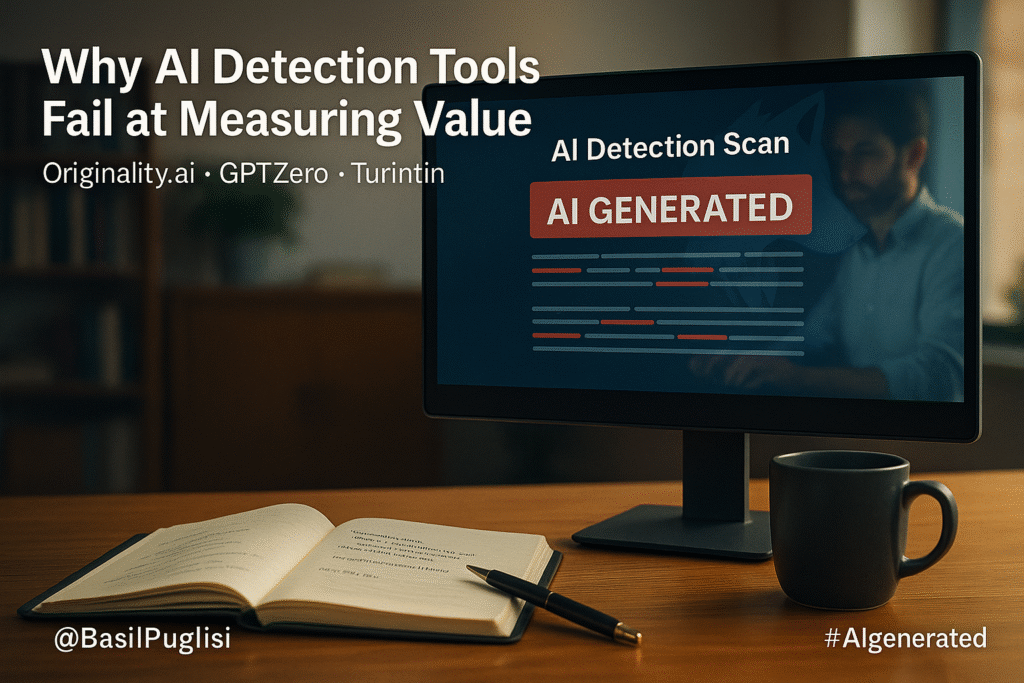
AI detection platforms promise certainty, but what they really deliver is confusion. Originality.ai, GPTZero, Turnitin, Copyscape, and Writer.com all claim to separate human writing from synthetic text. The idea sounds neat, but the assumption behind it is flawed. These tools dress themselves up as arbiters of truth when in reality they measure patterns, not value. In practice, that makes them wolves in sheep’s clothing, pretending to protect originality while undermining the very foundations of trust, creativity, and content strategy. What they detect is conformity. What they miss is meaning. And meaning is where value lives.
The illusion of accuracy is the first trap. Originality.ai highlights its RAID study results, celebrating an 85 percent accuracy rate while claiming to outperform rivals at 80 percent. Independent tests tell a different story. Scribbr reported only 76 percent accuracy with numerous false positives on human writing. Fritz.ai and Software Oasis praised the platform’s polished interface and low cost but warned that nuanced, professional content was regularly flagged as machine generated. Medium reviewers even noted the irony that well structured and thoroughly cited articles were more likely to be marked as artificial than casual and unstructured rants. That is not accuracy. That is a credibility crisis.
This problem deepens when you look at how detectors read the very things that give content value. Factics, KPIs, APA style citations, and cross referenced insights are not artificial intelligence. They are hallmarks of disciplined and intentional thought. Yet detectors interpret them as red flags. Richard Batt’s 2023 critique of Originality.ai warned that false positives risked livelihoods, especially for independent creators. Stanford researchers documented bias against non native English speakers, whose work was disproportionately flagged because of grammar and phrasing differences. Vanderbilt University went so far as to disable Turnitin’s AI detector in 2023, acknowledging that false positives had done more harm to student trust than good. The more professional and rigorous the content, the more likely it is to be penalized.
That inversion of incentives pushes people toward gaming the system instead of building real value. Writers turn to bypass tricks such as adjusting sentence lengths, altering tone, avoiding structure, or running drafts through humanizers like Phrasly or StealthGPT. SurferSEO even shared workarounds in its 2024 community guide. But when the goal shifts from asking whether content drives engagement, trust, or revenue to asking whether it looks human enough to pass a scan, the strategy is already lost.
The effect is felt differently across sectors. In B2B, agencies report delays of 30 to 40 percent when funneling client content through detectors, only to discover that clients still measure return on investment through leads, conversions, and message alignment, not scan scores. In B2C, the damage is personal. A peer reviewed study found GPTZero remarkably effective in catching artificial writing in student assignments, but even small error rates meant false accusations of cheating with real reputational consequences. Non profits face another paradox. An NGO can publish AI assisted donor communications flagged as artificial, yet donations rise because supporters judge clarity of mission, not the tool’s verdict. In every case, outcomes matter more than detector scores, and detectors consistently fail to measure the outcomes that define success.
The Vanderbilt case shows how misplaced reliance backfires. By disabling Turnitin’s AI detector, the university reframed academic integrity around human judgment, not machine guesses. That decision resonates far beyond education. Brands and publishers should learn the same lesson. Technology without context does not enforce trust. It erodes it.
My own experience confirms this. I have scanned my AI assisted blogs with Originality.ai only to see inconsistent results that undercut the value of my own expertise. When the tool marks professional structure and research as artificial, it pressures me to dilute the very rigor that makes my content useful. That is not a win. That is a loss of potential.
So here is my position. AI detection tools have their place, but they should not be mistaken for strategy. A plumber who claims he does not own a wrench would be suspect, but a plumber who insists the wrench is the measure of all work would be dangerous. Use the scan if you want, but do not confuse the score with originality. Originality lives in outcomes, not algorithms. The metrics that matter are the ones tied to performance such as engagement, conversions, retention, and mission clarity. If you are chasing detector scores, you are missing the point.
AI detection is not the enemy, but neither is it the savior it pretends to be. It is, in truth, a distraction. And when distractions start dictating how we write, teach, and communicate, the real originality that moves people, builds trust, and drives results becomes the first casualty.
*note- OPINION blog still shows only 51% original, despite my effort to use wolf sheep and plumbers…
References
Originality.ai. (2024, May). Robust AI Detection Study (RAID).
Fritz.ai. (2024, March 8). Originality AI – My Honest Review 2024.
Scribbr. (2024, June 10). Originality.ai Review.
Software Oasis. (2023, November 21). Originality.ai Review: Future of Content Authentication?
Batt, R. (2023, May 5). The Dark Side of Originality.ai’s False Positives.
Gold Penguin. (2024, September 18). Writer.com AI Detection Tool Review: Don’t Even Bother.
Capterra. (2025, pre-May). Copyscape Reviews 2025.

Leave a Reply
You must be logged in to post a comment.